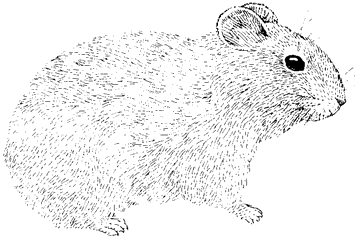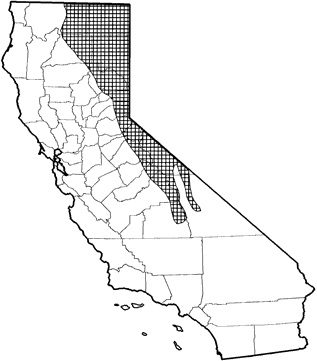
American Pika
Distribution, Abundance, and Seasonality
The American pika is a common resident of rock and talus slopes of the Cascades and Sierra Nevada from the Oregon border south to Tulare and Inyo cos. Populations are highly restricted to rock and talus slopes. Feeds at the edges of other habitats, principally alpine dwarf-shrub, subalpine conifer, lodgepole pine, wet meadow, and montane chaparral. Also feeds in perennial grassland, montane riparian, eastside pine, low sage, sagebrush, pinyon-juniper, red fir, Jeffrey pine, mixed conifer, and aspen. Many populations are insular, particularly those below timberline (Smith 1974a, Orr 1977).

Range Map
Specific Habitat Requirements
Feeding: The American pika eats a wide variety of plants, including grasses, sedges, forbs, and shrubs. Shrubs eaten include rabbitbrush, big sagebrush, and bitterbrush. Forages on the ground surface, primarily within 6 m (20 ft) of rock or talus in alpine meadows and other adjoining habitats. Well known for storing harvested vegetation in "hay piles". The haying season peaks in August, lasting from June to October. Plants in hay are higher in protein, lipids, and calories, and lower in fiber, than plants not selected (West 1980). Known to reingest fecal pellets, presumably to gain vitamins and protein, and to collect and eat marmot scats.
Cover: Colonizes rocky slopes, talus fields, or lava flows with many holes and openings to use as shelter. May inhabit abandoned mining sites or other suitable human-made debris. Markham and Whicker (1972) found that captive pikas in Colorado burrowed.
Reproduction: Uses crevices or holes among the rocks as nesting sites.
Water: Water needs are met from available drinking water and food.
Pattern: Prefers rock or talus bordered by alpine meadows or herbaceous understories of forest edges. The extent of rocky perimeter may be a good predictor of pika density, except for small insular populations (Smith 1979). The lower limit of pika distribution may be set by excessive heat (MacArthur and Wang 1973, Smith 1974b).
Species Life History
Activity Patterns: Yearlong diurnal activity. Some nocturnal vocalization has been reported (Orr 1977). Diurnal activity periods tend to be a function of temperature and altitude, with higher altitude populations foraging for longer periods and farther from cover (Smith 1974b). Activity is limited by high temperatures (MacArthur and Wang 1973, Smith 1974b).
Seasonal Movements / Migration: None.
Home Range: Reported home ranges include 0.3-0.5 ha (0.74-1.24 ac) (Barash 1973) and 0.26 ha (0.63 ac), varying from 0.04-0.30 ha (0.1-0.75 ac) (Kawamichi 1976). Reported densities vary from 4-22 per ha (1.6-8.8 per ac) (Millar 1974).
Territory: Pikas defend most of their home range, except during the mating season, when male territories expand to overlap with a female's. When the haying season starts, territories become more exclusive and more energetically defended. Reported territories are smaller than home ranges: 0.07 ha (0.18 ac), varying from 0.03-0.14 ha (0.08-0.34 ac) (Kawamichi 1976). Barash (1973) suggested that feeding areas are not always defended.
Reproduction: Mating occurs in the spring, and occurs later at higher altitudes. Gestation is about 30 days, and the young are born from March to August; most births occur from May to July. Litter sizes are usually 3 or 4, ranging from 1-6. There may be 2 litters per yr, but the second has lower survival than the first. The altricial young are weaned after 30 days, and lactation ends in September. The young breed for the first time as yearlings. Juvenile mortality is low, and pikas may live to 7 yr in the wild, though most do not survive past 5 yr (Millar 1972,1973,1974, Smith 1978, Svendsen 1979, Nowak and Paradiso 1983).
Niche: This diurnal herbivore occurs with the yellow-bellied marmot, Belding's ground squirrel, and various species of microtus on feeding areas. Predators include weasels, martens, and hawks.
Sources & References
California Department of Fish and Game, 1999.
California's Wildlife, Sacramento, CA.
Written by: J. Harris, reviewed by: H. Shellhammer, edited by: R. Duke, S. Granholm
Barash, D. P. 1973. Territory and foraging behavior of the pika (Ochotona princeps) in Montana. Am. Midl. Nat. 89:202-207. Broadbooks, H. E. 1965. Ecology and distribution of the pika of Washington and Alaska. Am. Midl. Nat. 73:299-335. Bunnell, S. D., and D. R. Johnson. 1974. Physical factors affecting pika density and dispersal. J. Mammal. 55:866-869. Johnson, D. R. 1967. Diet and reproduction of Colorado pikas (genus Ochotona). J. Mammal. 48:311-315.
Kawamichi, T. 1976. Hay territory and dominance rank of pikas (Ochotona princeps). J. Mammal. 57:133-148.
Lutton, L. M. 1975. Notes on territorial behavior and responses to predators of the pika (Ochotona princeps). J. Mammal. 56:231-234.
MacArthur, R. A., and L. C. H. Wang. 1973. Physiology of thermoregulation in the pika, Ochotona princeps. Can. J. Zool. 51:11-16. Markham, O. D., and F. W. Whicker. 1972. Burrowing in the pika (Ochotona princeps). J. Mammal. 53:387-389. Millar, J. S. 1972. Timing of breeding in pikas in southwestern Alberta. Can. J. Zool. 50:665-669 Millar, J. S. 1973. Evolution of litter-size in the pika, Ochotona princeps. Evolution 27:134-143. Millar, J. S. 1974. Success of reproduction in pikas, Ochotona princeps (Richardson). J. Mammal. 55:527-542. Millar, J. S., and F. C. Zwickel. 1972a. Characteristics and ecological significance of hay piles of pikas. Mammalia 36:58-68. Millar, J. S., and F. C. Zwickel. 1972b. Mortality of the pika, Ochotona princeps (Richardson). Can. J. Zool. 50:229-232.
Nowak, R. M., and J. L. Paradiso. 1983. Walker's mammals of the world. 4th ed. 2 vols. John Hopkins Univ. Press, Baltimore, MD. 1362pp.
Orr, R. T. 1977. The little known pika. MacMillan, New York. 144pp. Severaid, J. H. 1950. The gestation period of the pika (Ochotona princeps). J. Mammal. 31:356-357.
Smith, A. T. 1974a. The distribution and dispersal of pikas: Consequences of insular population structure. Ecology 55:1112-1119.
Smith, A. T. 1974b. The distribution and dispersal of pikas: influences of behavior and climate. Ecology 55:1368-1376. Smith, A. T. 1978. Comparitive demography of pikas (Ochotona): Effect of spatial and temporal age-specific mortality. Ecology 59:133-139.
Smith, A. T. 1979. Equilbrial population structure of pikas. Murrelet 60:29-31.
Smith, A. T. 1980. Temporal changes in insular populations of the pika (Ochotona princeps). Ecology 61:8-13. Svendsen, G. E. 1979. Territoriality and behavior in a population of pikas (Ochotona princeps). J. Mammal. 60:324-330. West, E. W. 1980. Adaptive patterns in behavior of the sierran pika, Ochotona princeps. Ph.D. Diss., Univ. California, Davis. 98pp.
California Animal Facts | California's Wildlife